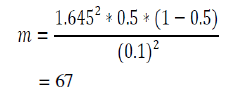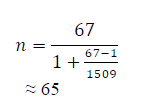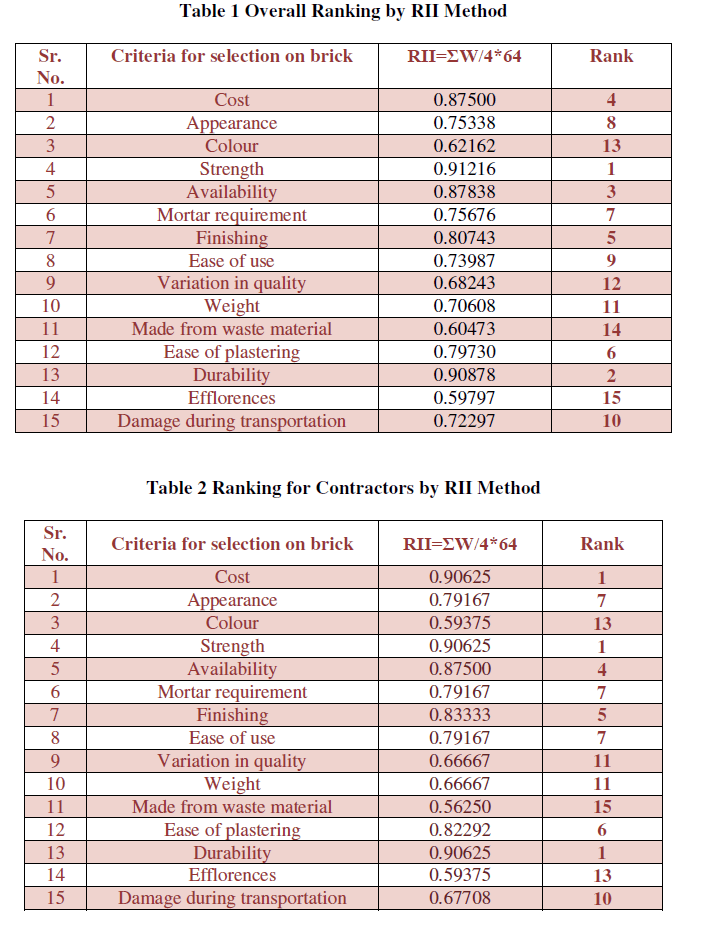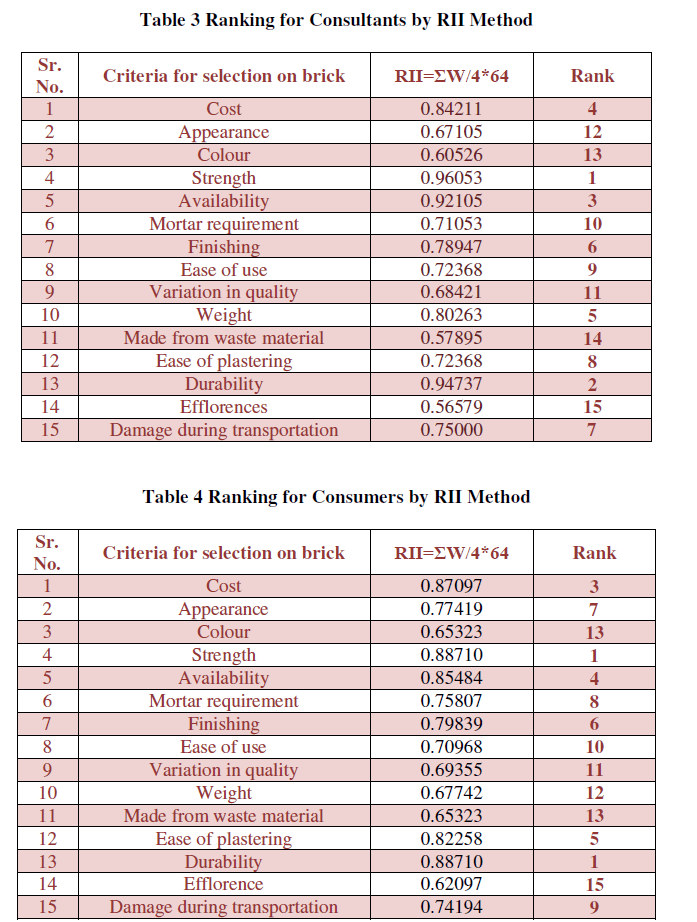ISSN ONLINE(2319-8753)PRINT(2347-6710)
ISSN ONLINE(2319-8753)PRINT(2347-6710)
Mr Bhaveshkumar M. Kataria1, Mr AbhiyanS. Patel2, Dr.Neerajkumar D. Sharma3, Mr Bhavin K. Kashiyani4
|
| Related article at Pubmed, Scholar Google |
Visit for more related articles at International Journal of Innovative Research in Science, Engineering and Technology
Clay brick, a major construction material throughout India, consumes natural clay for its production which results in consumption of natural resource and hence degradation of Mother Nature, again it consumes fuel for its maturing, which results in emission of harmful gases in the environment and results into pollution. Therefore government may ban it tosavethe natural resource and protect the environment. Also fly ash brick is made from fly ash basically which is mostly waste product of thermal power plant. Fly ash is waste and dumping of fly ash is major concern to industries. This study is based on the theme of ‘market survey’ and the aim is to check the feasibility of utilization of fly ash bricks in SURAT & TAPI district of Gujarat. We have use RII technique to carry out most common factors affecting selection of Brick which are looked for by Consultants, Contractors & Consumes. Total 110 Survey Questionnaires were distributed to Respondents (Consultants, Contractors & Consumers) in Surat&Tapi district of South Gujarat Region, from which 74 Responses were collected in that 19 were from consultants, 24 were from contractors and 31 were from consumers. These data was Analyzed by using RII technique. For Overall respondentswe find that Strength, Durability, Cost & Availability are Top Four ranking factors which affect the selection of Brick in this region.
Keywords |
| Feasibility of Fly ash brick, Relative Importance Index technique, availability, South Gujarat Region. |
INTRODUCTION |
| Clay brick is recognized as a major construction material throughout India. It consumes natural clay to produce the clay brick which results in consumption of natural resource and hence degradation of Mother Nature, again it consumes fuel for its maturing, which results in emission of harmful gases in the environment and results into pollution. Only because of this reasongovernment may ban it tosavethe natural resource and it is also beneficial for our environment. |
| On the other hand, fly ash brick is made from fly ash which is a by-product of thermal power plant. Fly ash is waste and dumping of fly ash is major concern to industries. If we use fly ash brick instead of clay bricks, we can protect environment from fly ash waste as well as we can conserve natural resource “clay”. |
| This study is based on the theme of ‘market survey’ and the aim is to check the feasibility of utilization of fly ash bricks in SURAT & TAPI district of Gujarat. |
II. OBJECTIVES OF STUDY |
| a. To identify variables influencing use of fly ash bricks and to evaluate their relative importance. |
| b. Investigate the collective group perspectives on the relative significance of these factors from owner, Manufacturer and contractor point view. |
| c. To generate relative importance of criteria in the form of numeric value by an Analytical Hierarchy Process technique for feasibility of utilization or acceptance of fly ash bricks in construction industry of SURAT & TAPI District of Gujarat. |
III. FACTORS CONSIDERED FOR STUDY |
| The various Factors affecting selection of Brick are determined by viewing various literatures. From that 15 factors considered for this study are: Cost, Appearance, Colour, Strength, Availability, Mortar Requirement, Ease of Use, Finishing, and Variation in Quality, Weight, and Made from waste material, Ease of Plastering, Durability, Efflorences, Damage during transportation. |
IV. RESEARCH METHODOLOGY |
| The research methodology for present study based on questionnaire survey which was prepared based on above considered factors. This questionnaire is based on approach of ranking the Factors affecting selection of bricks. The Relative Importance Index(RII) technique is used to rank the factors.The questionnaire for survey was distributed to contractor, consultants and consumers to seek their view. |
V. DATA COLLECTION |
| The target population included civil engineering and buildings construction firms of South Gujarat region of India. The Consumers, Consultants and contractors of Surat&Tapi district of South Gujarat were targeted for survey. The details of various stakeholders and total numbers of them were collected through internet. These details were considered as size of population to decide sample size of study.To obtain a statistically representative sample of the population, the formula shown in Eq. (1) was used: |
 |
| Where n, m, and N = the sample size of the limited, unlimited, and available population, respectively. m is estimated by Eq. (2): |
 |
| Where z = the statistic value for the confidence level used, i.e., 2.575, 1.96, and 1.645,for 99%, 95%, and 90% confidence levels, respectively; p = the value of the population proportion that is being estimated; and å = the sampling error of the point estimate. Because the value of p is unknown, suggested a Conservative value of 0.50 be used so that a sample size that is at least as large as required be obtained. By using a 90% confidence level, i.e., 10% significance level, the unlimited sample size of the population, m, is approximated as follows: |
 |
| Accordingly, for the total number of consultant, i.e., N, of 1509, the representative sample size of the population required, is determined as shown below: |
 |
| Similarly, Sample size of contractor≈ 65 |
| Similarly, Sample size of consumer≈ 65 |
| First of all, list of the stakeholders was generated from local survey and the internet through their websites and accordingly questionnaires were distributed to various stakeholders by going personally or through email.personal interview and mail back techniques were used in this research, where respondents had a clear opportunity to take part or not; therefore, the voluntary participation in research was ensured. The telephone number, e-mail contacts and address of researcher were given in the questionnaire for contact regarding any query as well as for sending back the response. The questionnaire were distributed to various stakeholders by informing them regarding the purpose of the research and asking them about their willingness to participate in the research. Once the initial willingness was shown by them, a questionnaire was given to them. Total 110 questionnaires were distributed to different respondents in Surat&Tapi district of South Gujarat. They were sent the reminder for sending their feedback after 10 to 15 days of sending the questionnaire. This study received 74 responses. So, the response rate in this research is 67.27 %, which is considered as very good in this kind of survey. |
VI. DATA ANALYSIS APPROACH |
| Relative Importance Index technique was used for ranking the factors affecting selection of Bricks in this Survey. |
| The Relative Importance Index (RII) will be used to rank (R) the different factors affecting selection of brick. These rankings make it possible to cross-compare the relative importance of the factors as perceived by the three groups of respondents (i.e. consumers, consultants and contractors). Each individual factor’s RII perceived by all respondents will be used to assess the general and overall rankings in order to give an overall picture of the factors that affect selection of brick in Surat and Tapi district of Gujarat. The formula to calculate RII given below: |
 |
VII. RESULTS AND FINDINGS |
| The all ranking indices explained earlier were used to rankdelay causes from viewpoints of the three parties (Consultants,Contractors and Consumers). Total 74 respondentsparticipated in this survey. These respondents included 19 Consultants, 24 contractors and 31Consumers. |
| The ranking by RII technique is determined for Consultants, Contractors and Consumers Individually as well as Ranking for Overall Respondents is also calculated. |
 |
 |
VIII. CONCLUSIONS |
| Total 15 factors affecting selection of Brick were identified through literature study & experts opinion. As per population of stakeholder in Surat&Tapi district of South Gujarat region total 195 number of respondents were required. Due to time constraints, it was possible to distribute 110 questionnaire to stakeholders. This study received 74 responses. So, the response rate is 67%. Respondents were comprised of 24 contractors, 19 consultants and 31 consumers. The collected data was analysed through Relative Importance Index technique. The major conclusions arrived are: |
| As per RII technique, Top Four factors affecting selection of Brick by Consultants respectively: |
| • Strength |
| • Durability |
| •Availability |
| •Cost |
| As per RII technique, Top Four factors affecting selection of Brick by Contractors respectively: |
| •Cost |
| •Strength |
| •Durability |
| •Availability |
| As per RII technique, Top Four factors affecting selection of Brick by Consumers respectively: |
| •Strength |
| •Durability |
| •Cost |
| •Availability |
| As per RII technique, Top Four factors affecting selection of Brick by Overall Respondents respectively: |
| •Strength |
| •Durability |
| •Cost |
| •Availability |
| Hence, we can say that Utilization of Fly ash Bricks in Surat&Tapi district of South Gujarat Region is Feasible if we mainly govern Strength, Durability, Cost and Availability factors for Fly ash Bricks. |
ACKNOWLEDGMENT |
| The authors are thankfully acknowledge to Mr. J. N. Patel, Chairman Vidyabharti Trust, Mr. K. N. Patel, Hon. Secretary, Vidyabharti Trust, Dr. H. R. Patel, Director, Dr. J. A. Shah, Principal, S.N.P.I.T. & R.C., Umrakh, Bardoli, Gujarat, India for their motivational & infrastructural supports to carry out this research. |
References |
|